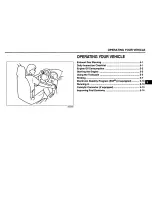
WARNING!
To assure that spare tires, flat or inflated, are securely stowed, spares must be stowed
with the valve stem facing the ground.
• Secure the tire, jack (base of jack faces rear of vehicle), and tools in their proper
locations.
TIREFIT Instructions
• TIREFIT will temporarily seal small punctures up to
1
4
in.(6 mm) in the tire tread allowing
you to drive your vehicle up to 100 mi (160 km) with a maximum speed of 55 mph
(90 km/hr). TIREFIT can be used in outside temperatures down to approximately -4°F
(-20°C).
NOTE:
Do not remove foreign objects (e.g., screws or nails) from the tire.
• Verify that the valve stem is close to the ground.
• Put on the gloves from the TIREFIT Kit Accessory Storage Compartment.
• Turn the Mode Select knob to the Sealant Mode position
.
• Remove the Yellow Cap from the fitting at the end of the Clear Sealant Hose.
• Remove the valve stem cap and screw the fitting at the end of the Clear Sealant Hose
onto the valve stem.
• Insert the Power Plug into the vehicle’s 12-volt power outlet.
• Start the engine and then press the Power button
. The sealant (white fluid) will
flow from the Sealant Bottle through the Clear Sealant Hose and into the tire.
NOTE:
• Sealant may leak out through the puncture in the tire.
• If the sealant (white fluid) does not flow within 0 – 10 seconds through the Clear
Sealant Hose:
• Press the Power button
to turn OFF the TIREFIT kit.
• Disconnect the Clear Sealant Hose and make sure the valve stem is free of debris.
• Repeat previous steps to verify sealant will flow, making sure the Mode Select
knob is in Sealant Mode
.
• Continue to operate the pump until sealant is no longer flowing through the hose
(typically takes 30 - 70 seconds). As the sealant flows through the Clear Sealant Hose,
the pressure gauge can read as high as 70 psi. The pressure gauge will decrease
quickly from approximately 70 psi to the actual tire pressure when the sealant bottle is
empty.
• The pump will start to inject air into the tire immediately after the sealant bottle is
empty. Continue to operate the pump and inflate the tire to the pressure indicated on
the Tire and Loading Information label on the driver's side door opening. Check the
tire pressure by looking at the pressure gauge.
WHAT TO DO IN EMERGENCIES
48
Summary of Contents for 2009 Challenger
Page 4: ......
Page 7: ...INTRODUCTION 5 1...
Page 10: ......
Page 104: ...102 UNDERSTANDING THE FEATURES OF YOUR VEHICLE...
Page 105: ...UNDERSTANDING THE FEATURES OF YOUR VEHICLE 103 3...
Page 106: ...104 UNDERSTANDING THE FEATURES OF YOUR VEHICLE...
Page 152: ......
Page 158: ...INSTRUMENT CLUSTER BASE 156 UNDERSTANDING YOUR INSTRUMENT PANEL...
Page 159: ...INSTRUMENT CLUSTER PREMIUM UNDERSTANDING YOUR INSTRUMENT PANEL 157 4...
Page 240: ......
Page 299: ...STARTING AND OPERATING 297 5...
Page 439: ...INDEX 10...
Page 462: ...includes SRT8 2010...
Page 467: ...DRIVER COCKPIT 4 CONTROLS AT A GLANCE...
Page 468: ...5 CONTROLS AT A GLANCE...
Page 487: ...NON TOUCH SCREEN RADIOS Sales Code RES Sales Code RES RSC ELECTRONICS 24...
Page 508: ...Jack Spare Tire Location TIREFIT Kit Location 45 WHAT TO DO IN EMERGENCIES...
Page 522: ...ENGINE COMPARTMENT 3 5L Engine 59 MAINTAINING YOUR VEHICLE...
Page 523: ...5 7L Engine 60 MAINTAINING YOUR VEHICLE...
Page 524: ...6 1L Engine 61 MAINTAINING YOUR VEHICLE...
Page 530: ...Fuses Rear Power Distribution Center 67 MAINTAINING YOUR VEHICLE...
Page 539: ...NOTES 76...
Page 540: ......
















































